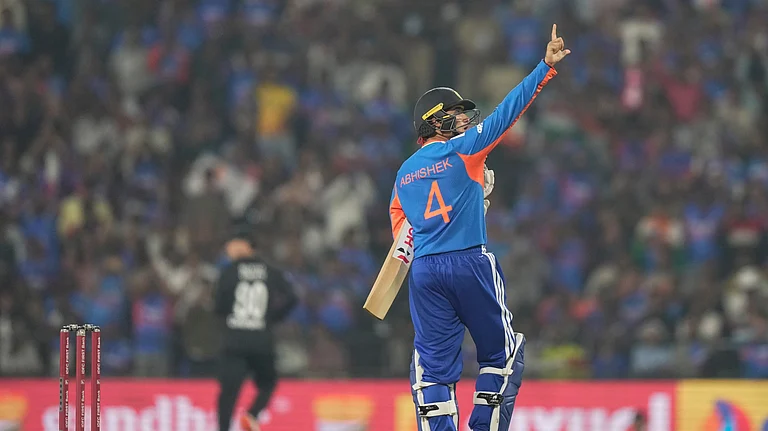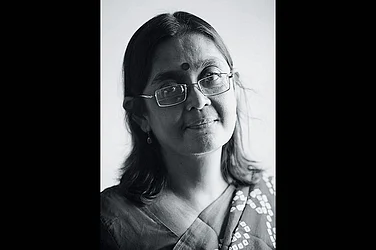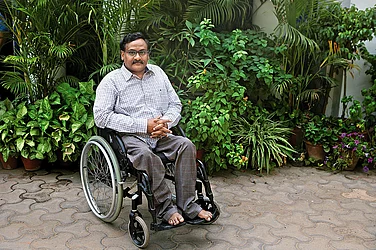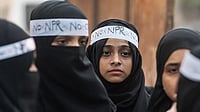Mumbai’s 38-year-old Pallavi Palekar gave up her job after she heard a lecture on the importance of being with the child when they are young. “The maids cannot give the child the culture that is special to every family,” says Palekar. “I had a good job, now I take tuition at home. I have also enrolled my six-year-old for Raviwar Shala and I can see a change in his behaviour. The naughtiness has reduced and he has started listening to what I say,” she says.
Upper caste homemakers in cities like Mumbai, Delhi, and Thane are the new target group of Hindu preachers aligned to various groups under the ambit of their mother organisation, the Rashtriya Swayamsevak Sangh (RSS). While the upper caste men are joining the shakhas of the RSS, the women align themselves with the likes of a Malti Tai and Guru Ma, who preach Hindutva through the experiences of daily living. In the last seven sessions of the Right-aligned groups, gendered talk on the role of the homemaker, particularly Brahmin women, came up as a crucial point of focus. “A woman who goes out to work neglects her home. Today, the Hindu traditions are dying because of such women who do not do pooja or fast on auspicious days,” was the lesson at one of these sessions.
In her commanding voice, Malti Tai, an RSS pracharak (worker), warns: “You have to watch your daughters, keep them under control. Girls are running away, drinking, smoking, and going out with boys. You never know what your daughters do outside the house. Be vigilant.” According to her, the personal belongings of their daughters must be checked—even if they are grown up and working—and they should get back home at a regular time.
“Marry them off once they are 22. They will have children early and such children are intelligent. No Hindu must keep their daughters at home after they are 21,” she says. Her solution to girls “going wayward” is through “Garbh Sanskar”. “The way you live has a direct impact on the foetus. Don’t eat onions and garlic during pregnancy. Otherwise, your child will be a tamsik (vengeful),” she says eyeing the younger women. “There is an auspicious time when a couple should start planning the woman’s pregnancy. When followed, the beej (sperm) will be good and the child is often a boy.”
In an apartment building in Thane, Anuja Sahasrabuddhe prepares for her “class” comprising 25 women, meeting every Thursday in different homes. “We talk about the teachings of Sant Dynaneshwar and Sant Ramdas. We discuss the Ramayana and how to use it in our daily living,” says Sahasrabuddhe. An older woman—their Guru Ma— walks in and says: “You should never enter the kitchen in the morning without a bath. Today, no woman follows this which creates bad energy in the house. When a woman’s energy is good, the energy of the house is good,” says Guru Ma.
“Is this a new member? Why was I not told about this member?” she queries pointing in the direction of this correspondent. “I was told that you know her, Guru Ma,” blabbers Sahasrabuddhe. “Tell us your name and why are you here?” ask the women. “See, she is not wearing a bindi. She must be a spy of the Muslims. Call the security,” shouts one woman. Getting out of the flat with the security guard of the building was a better option than being in a room full of screaming women.
In Politics, Emotions and Ethics in ‘New India’, professor Ajay Gudavarthy highlights that the RSS, in a true age-old Brahaminical fashion, upholds itself above society’s collective gaze and suffers from a disdain of public ethics as against its structured morality, even as it instrumentally uses and routinely condemns it. This Chanakya Neeti is visibly clear as one attempts to trace RSS activists working under its different projects and activities. “We have launched a nationwide signature campaign demanding a Hindu Rashtra, Uniform Civil Code, and population control bill,” says Dharmendra Keserwa, a Kutumba Prabodhan worker in western Uttar Pradesh. Keserwa refers to Chaudhary Harpal Singh, Delhi Adhyaksh for RSS’ Kutumba Prabodhan for any further details of their work. Singh, however, refuses to share any input or quote on the same.

Kama Muta: The Science of Emotions
Emotions influence an individual’s decision-making capacity and process, irrespective of their rationality. Stimuli from the outside world hit our thalamus and go straight to the amygdala, an ancient emotion centre of the brain, and only then travel to our neocortex where all the rational thinking actually happens. The emotional centre (amygdala) processes information milliseconds earlier than the neocortex, which then leads to irrational acts.
Inspiration, encouragement, nostalgia, fear, hate, pride, and provocation are often exploited or built upon for a deeper connection and understanding of the human psychology of the targeted audience. Based on these psychological triggers in the longer run, the RSS-BJP parivar has successfully been exploiting the voters and influencing their voting patterns. This political advertisement in the vernacular can be referred to as the concept of ‘Kama Muta’.
The cult-like following it has managed to forge would have not been possible merely through the politics of hate, but through the amalgamation of both positive and negative emotions; relying on the narratives of glorious history, strength, honour and purity. The RSS seeks to evoke Kama Muta—an emotion described as ‘being moved’, ‘heart-warming’, ‘stirring’ or ‘being emotionally touched’—to invoke the feeling of rapture associated with the fusion of a collective body.
“Shakha is our factory which builds characters,” says a 70-year-old RSS worker, with pride shining through his old eyes, embodying how the present government has offered to rise above criticism and failures and stand together as a ‘family’, even if they continue to neglect to include those left behind.
It is the RSS’ Seva branch, Parivar Prabodhan, Panna Pracharak and the ABVP that have contributed to the ground support of PM Modi. The ideology behind this neeti of the RSS is: “Everyone cannot come to the shakha, so we go to them.” From finding jobs, brides, grooms and to helping senior citizens cope with loneliness, RSS’ Panna Pracharaks take responsibility of a certain number of households as listed within the pages of the voter’s list. Pune-based Bhaisaheb Patwardhan says, “My children live abroad and visit once in three years. My wife and I were very lonely. One day, the chairman of our society brought a person to my house. Since then, he has been keeping in touch with the households in this building.”

“Money is not an issue, but loneliness is. Our children are never there when we need them, he is the son of everyone in this building,” says Shraddha Tai, Bhaisaheb’s wife. When 32-year-old Vasanti was unable to find a groom, the family sought a paan pracharaks’s help who had connected with the residents during the Covid-19 lockdown. “My daughter is a manglik and was not finding a groom. When he heard about it, he offered help.”
With events in households, localities, temples and even schools, RSS affiliates tend to encourage families to eat together, increase communication and build strong Sanatan ethics and values. “We have prepared a nine-pointer for families to follow. This includes praying to god, reciting a mantra, or chanting Hanuman Chalisa before eating. Hold at least a 10 minutes discussion on the subject of our traditions, great men (mahapurush) and ancestors. We call this grih sabha, so that the elders also talk to their children and understand them,” a Kutumba Pbodhan member explains.
A Prabodhan worker says that the true ways of a Sanatan family are reflected in the presence of a tulsi plant, a dhwaja (flag), mandir (temple), dhoop-agarbatti (incense sticks), and how they celebrate birthdays. “Irrespective of the events, functions, and programmes, we have just one focus just as Arjun’s,” the prabodhan member says, that is to “perpetuate the emotion of deshbhakti (nationalism) and to bring nation first in everyone’s hearts”.
While the upper caste and upper-class Hindus carry the work for the RSS in posh areas and localities, boys from lower and middle-income groups of impressionable ages are recruited as the younger foot soldiers of this Hindu organisation.
Crises of Emotions
Addressing a gathering of over 50 people inside a school campus in New Delhi after hoisting a Bhagwa flag on Guru Purnima, a disgruntled RSS worker says, “Our national flag was to be saffron, but the so-called secularists inserted two other colours. It is the saffron flag which is our Guru dhwaj.”
Display boards in the classroom showcase ‘Bharat ke veer balak’ with pictures of Hindu mythology characters, Shivaji and Haqeeqat Rai. The board glorifies Chittorgarh Johar (mass self-immolation). On the opposite wall are pictures of Rani Laxmi Bai, Bhagat Singh, Tagore, Vajpayee, Subhash Chandra Bose, Sardar Patel and Chandra Shekhar Azad. “To develop a national education machinery that would build a youth brimming with Hindu allegiance and nationalism...” reads the beginning of a third board in a room titled humara lakshya (Our agenda).
Claiming that it has no other means of generating funds, the RSS raises funds through Guru Dakshina. The exercise begins with Guru Purnima and continues for over a month. It reignites the guru-shishya paddhati (ritual), a Hindu tradition in ancient India. There was no better location to host the programme and generate Guru Dakshina, than in an educational institution run by the RSS itself.
Among the two primary issues discussed in the school campus included raising money for the Hindu nation and the ‘Muslim threat’. “Millions of money are injected into our country for the spread of Islam. There is only one Hindu nation and we would succumb to the Islamic conspiracy if we don’t buck up now,” the RSS leaders warn.
Very few children, women and youth can be seen at these events organised and attended by the upper-middle-class urban population who are senior Supreme Court advocates, retired government officers, and businessmen. Ironically, it is the constant criticism of nuclear families and Western culture, which lay grounds for the Sangh’s activity of Kutumba/Parivar Prabodhan. “Every time society is going through a crisis, Sangh steps in to intervene. It was in 2007 that a top RSS leader felt that our society’s family structure was breaking up due to a communication gap and Westernisation. That’s why he proposed the idea of Kutumba Prabodhan,” says a Prabodhan worker.
But the Sangh’s teachings are at odds with the culture and practices of other communities and regions. Take Jharkhand’s Rajni Murmu, who says that beef was always part of their food culture until one day her grandfather announced it won’t be cooked anymore. “RSS workers would visit our village in Deoghar, Madhupur, and say that cows should be revered and not consumed,” says Murmu. “Vermilion was never a requisite for married Adivasi women. In fact, those applying vermilion were thought to be influenced by outside modern culture. But now Adivasi women mimic Savarna Hindu women,” Murmu observes. A former professor, Murmu, says that interference from the upper caste Pracharaks (Dikus), who were always richer, made them better than the Adivasis. This psychology helped them to Hinduise Adivasi men and women. “Live-in, love marriages and divorces were normal in Adivasi culture. Women were free to stay out of their homes late night and enjoyed autonomy. The RSS ideology mocked our traditions and triggered our inferiority complexes. Pre-existing gender inequalities deepened in our own society as arranged marriages, higher control on women’s bodies and adapting upper caste traditions have now become a norm.”
Haima Deshpande & Swati Shikha
(This appeared in the print as 'House Calls')


























